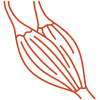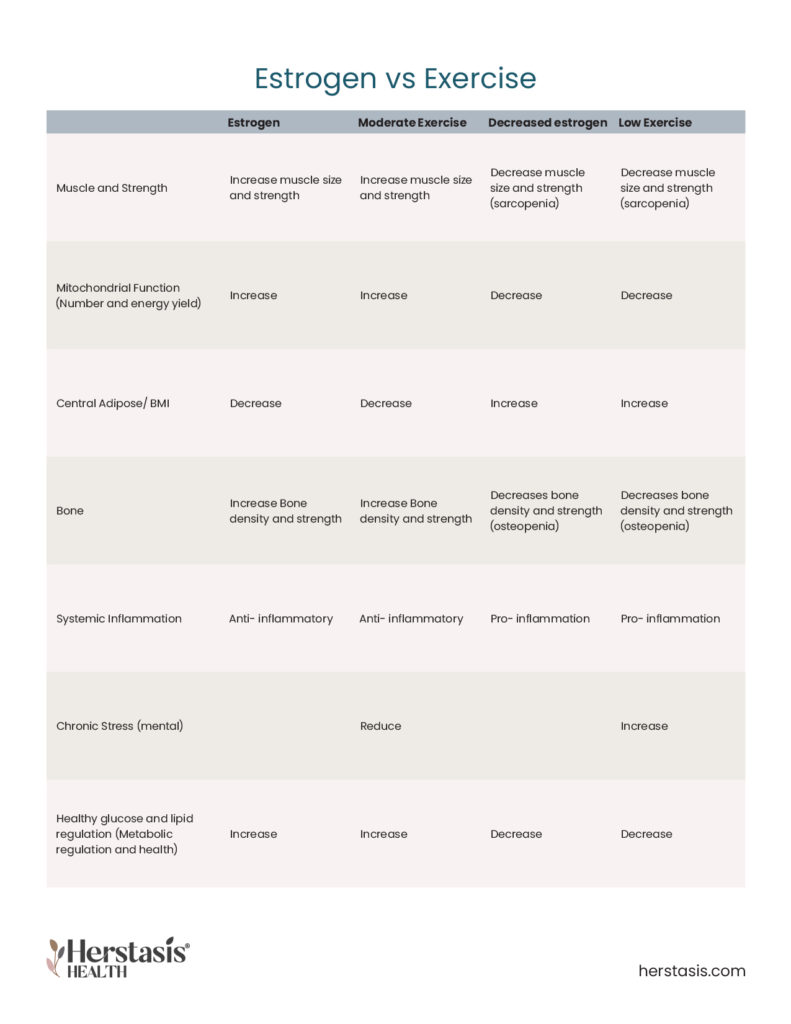Why move During Menopause?
Exercise and recreational movement are one of the best therapies for chronic stress, insomnia and building healthy adipose (or fat) tissue. Even better, research is showing that physical activity and exercise may have the same effects on your body and brain that estrogen has.[5][6][7][8][9][10]
The recommended amount of exercise and movement during menopausal transition is about 300 minutes per week (or about 40 minutes a day), just slightly different than for women in earlier stages of life.[11][12]
While that may seem like a lot, the activity doesn’t have to happen in one chunk. Multiple short amounts of movement totaling 40 minutes per day will suffice – and any movement you do will add up quickly!
Knowing all this, and knowing that good health has a positive impact on the transition into menopause, it is never too late to start increasing recreational movement and exercise and feeling the benefits!!
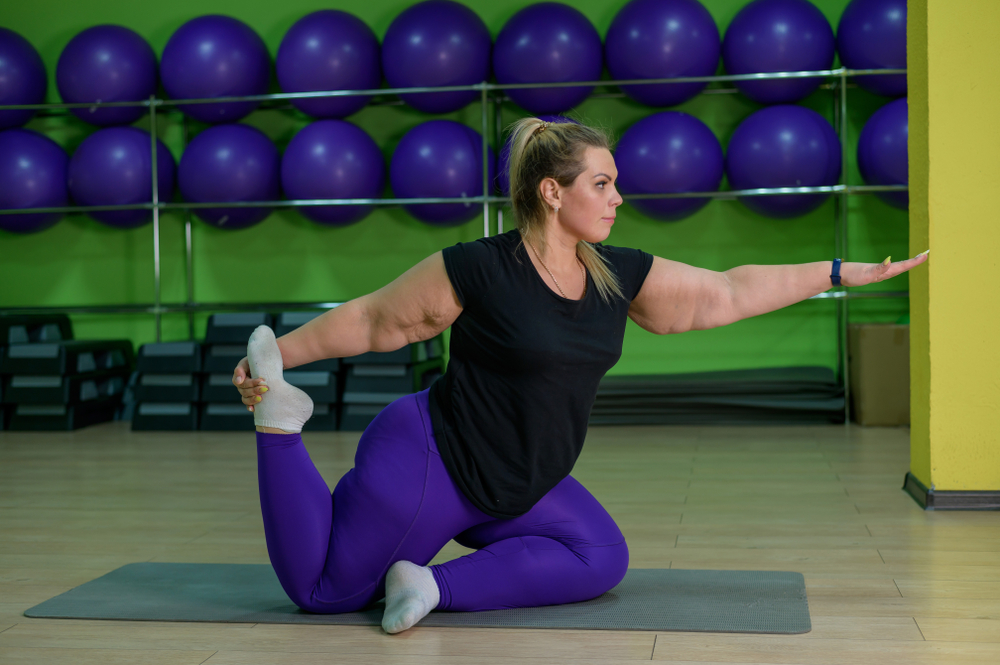
Accessing Exercise & Recreational Movement
Accessing exercise and recreational movement can be as simple as adjusting your daily routine. Typically though, increasing your exercise and activity levels involves planning and accepting some moderate changes to your lifestyle.
If you find that you don’t have time to squeeze recreational activities into your day, remember, they don’t need to take up lots of time. Plan some short walks around your neighborhood or 10 minute blocks of stretching on your living room floor. Once a week, walk to the shopping center instead of driving. Be creative. If you take transit, get off one stop early and walk the extra distance.
Many women live in a movement-restricted environment, working long hours in a small work-space, or living in cramped housing. There are many free yoga and movement videos that can be completed on a mat with minimal or no extra equipment. If you need to get out of your work or living space, try joining a gym, a martial arts dojo, or a dance studio. Community centers, schools and the YWCA also have many facilities.
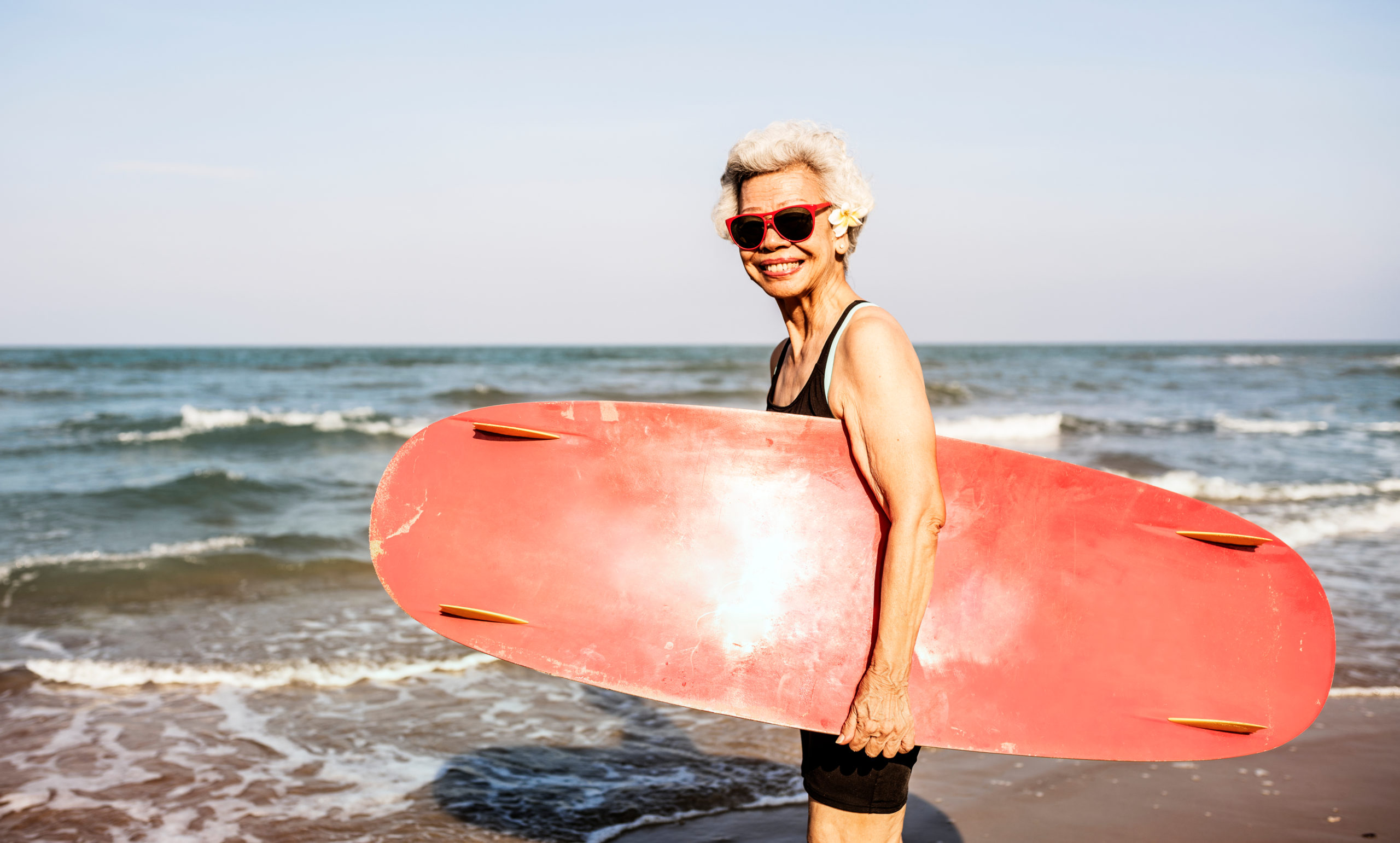
Options for Exercise & Recreational Movement
Many women view ‘exercise’ as a formal activity like a boxercise class or a training session at the gym – this may be true, but that isn’t the only way to get your exercise. Consider mixing and matching some of these options:
Do this for at least 30 minutes each day, 5- 6 times a week. This can be as simple as walking briskly for one half hour. Other activities that will get your heart rate up include swimming, cycling, running/jogging, soccer, rugby, ultimate frisbee, tennis, shaking your booty to your favorite music or walking your dog.
Despite many women’s beliefs that this will make them bulky, it is just the opposite. Two weekly sessions of weight training can help to preserve your bone density and build and retain muscle mass. When you start, it is advised to work with a physiotherapist, kinesiologist or a specialized personal trainer to set appropriate and achievable goals and techniques. You may also want to get a bone density analysis before starting any weight training, especially if you have had low- impact fractures, if you are underweight, or if there is a family history of bone density issues.
If you believe exercise = sweat and that appeals to you, then two weekly sessions of HIIT is a good fit. HIIT will stimulate heart strength and circulatory conditioning. Jumping rope, rowing or skiing ergometers, sprinting, swim sprinting, martial arts, and tennis are some options. Have fun with thinking of ways to get a good sweat on!
Square dancing. Stand up paddle boarding. Indoor rock climbing. Orienteering. Dancing to music at your local nightclub. Grooving at live concerts. Belly dancing. Volunteering at the animal shelter walking dogs. Baling hay. Surfing. Scavenger hunting. Mall walking. The list is endless and can be completely tailored to your interests, your lifestyle and your budget.
The reality is that not everyone can do all activities. There are multiple options available if you have physical challenges like the following:
Try Pain Neuroscience Education (PNE), also known as therapeutic neuroscience education (TNE). Pain is, well, painful, and it can be debilitating, but you can adjust your sensitivity and response to it with PNE. PNE educates patients by describing the neurobiology and neurophysiology of pain and pain processing by the nervous system. PNE works most effectively if you can work with a trained clinician who can provide Motivational Initiative (MI) in combination. PNE is effective for chronic pain and fibromyalgia.[13][14][15][16]
Gliding sports are great for injured or painful knees. Try rollerblading, swimming, deep water running, water polo, paddling, and kayaking.
For almost every sport, there is an adaptive modification. These include (but are not limited to) adaptive skiing, swimming, cycling, rowing, nordic skiing, and kayaking. Some physio or rehab clinics have special equipment that can be used to support your body while gaining strength or undergoing gait training.
If you have health issues such as diabetes, cardiovascular, or metabolic disease, start by getting a thorough physical exam and then work closely with a qualified care provider (medical care providers, physiotherapists or physical trainers) to design an exercise program. Specific assessments, such as a PAR-Q assessment can inform your health team and provide guidance for them to develop a realistic program that suits your needs and your abilities.
The Science
- The similarities between the effects of estrogen and exercise training for women’s health have been revealed in recent research.
- Exercise and estrogen both have anti-inflammatory effects throughout the body.
- Exercise and estrogen both increase the number and health of “metabolic energy powerhouses”: organelles called mitochondria
- Exercise and estrogen both strengthen bones and keep the immune system healthy.
- Some researchers propose that the right kind and amount of exercise during perimenopause and post- menopause could counteract the effects of declining estrogen throughout a woman’s life.[17][18][19]
Estrogen regulates many of the important metabolic functions of organs, cells, and genes in most cells of the body beyond just sex and reproduction. All of our body’s biological systems work together to obtain food, eat and digest it, and turn it into chemical energy — this is the process of metabolism. Subsequently, metabolic energy can be used to repair tissue, provide movement, process information, allow reproduction, and give the immune system defense against pathogens. The interactions between metabolic control of your body, reproduction, and the function of the immune system need to be matched and coordinated, a process sometimes called immunometabolism.[21][22]
Tissues and organs that are sensitive to estrogen also communicate with each other using a variety of different biochemical signaling molecules. A complex network of biochemical communication is involved in exercise response, and while these messages might be different they have an amazingly similar effect on health. Disruption of this communication network causes many of the unhealthy effects of aging.
Adipose (fat), muscle, and bone tissue, as well as cells of the immune system are all very sensitive and responsive to estrogen due to high levels of estrogen receptor proteins. Their functions often decline during and after the perimenopausal transition, and this is caused partly by the reduction and eventual disappearance of ovarian-generated estrogen. But the decline also stems from reduced physical activity in peri- and post- menopausal women. [23][24][25]
How comparable are the responses of these tissues to estrogen and exercise? How does the loss of estrogen from menopausal transition reflect the loss of function from lack of physical inactivity? Read on!
Statistics
Minutes a day total of multiple short movement sets will suffice!
‘No Pain, No gain’ : Time to get a new mantra because it just isn’t true. Go at your own pace and enjoy yourself.
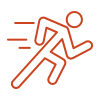
Number of times per week you should move for at least 30 minutes. Pick something you enjoy!
MYTH
It is trite but true – if you have time to look at this website, you have time to move. Really! Make a list of 5-minute time pockets in your day where you can break from your work screen, social media (or family) and move around. Build walking or cycling into your commute.
MYTH
Beauty is in the eye of the beholder! The variety of colours, shapes and sizes of people is what makes the adventure of being human and observing the world interesting. You have a choice with how you move.
MYTH
It’s just the opposite. Exercise is an absolutely critical part of your overall health, mental as well as physical. Put your physical and mental health first! Even if you feel silly when you are learning a new skill, who cares? One of the treasured parts of growing older is letting go of concerns about ‘what others think’. And if you still feel silly, choose to be active early in the morning or late at night when you will have less of an audience.
MYTH
It just isn’t true. Go at your own pace and enjoy yourself. If you have a trainer, make sure they are compassionate, qualified and willing to listen to you so you can tailor a program that suits you and keeps you engaged.
That’s ok! There is no need to damage yourself or push yourself beyond your comfort zone. Try non-weight bearing exercises such as swimming, water polo (yes!), synchronized-swimming, aquacise, deep- water running, cycling, rollerblading, or try low- impact tai- chi and martial arts. Enjoy some gentle daily stretching exercises.
Muscle development and bone density will improve regardless of your size. Recreational movement and exercise do not need to be about losing weight. Resistance exercise, with or without aerobic exercise, can help reduce the health problems linked to obesity. Concentrate on having fun!65
Exercise is like colour. There is more than one type! So you may hate purple, but thankfully there are lots of other colours you can paint your kitchen! The beauty of movement is that it comes in so many forms. With a bit of positive self-talk, give yourself permission to try new things. There is something out there that you can do AND enjoy! Dance, learn creative American sign language, try circus events like juggling, bandaloop aerial silks, and unicycling. And of course, there are always hoola-hoops! ….whatever it takes to move and have fun.
If you hate exercise, first identify what exactly it is you hate. If it’s sweating on a bicycle in the heat while the seat bruises your delicate bits, then…don’t cycle. If it’s squeezing into tights to do an aerobics class then…don’t wear tights and don’t do aerobics.
FALSE
Adaptive physical activity and recreation are available. Try adaptive skiing (Nordic or downhill), water sports, cycling, kayaking, and paddle boarding. Wheelchair orienteering is a sport that can be done in teams or solo, urban or countryside. Find a physiotherapy clinic in your area that specializes in creating movement plans for people with mobility limitations.
MYSTERY
Estrogen is a “super regulator” of metabolism and energy, especially in women. During the menopausal transition, and post- menopause, estrogen declines to a very low level. Recent evidence shows that exercise mimics the effects of estrogen.
Why enquire about movement therapy?
Increase
movement and decrease chronic stress!
Increase
your movement and increase the healthy glucose and lipid regulation in your body!
Decrease
adipose tissue with moderate exercise and movement!
Decrease
in estrogen causes a decrease in muscle size and strength. Get moving and try out resistance training!
Compiled References
- Minkin, M.J. (2019) Menopause: Hormones, Lifestyle and Optimizing Aging. Obstet Gynecol Clin N Am 46 501–514 https://doi.org/10.1016/j.ogc.2019.04.008
- World Health Organization (2007). Women, aging and health : a framework for action: focus on gender.
- Kalache A, and Kickbusch I. (1997). A global strategy for healthy ageing. World Health, 1997, 4:4–5.
- Dugan, S.A., Pettee, G., Lange- Maia, B., Karvonen- Gutierrez, C. (2018) Physical activity and physical function: moving and aging. Obstet Gynecol Clin North Am. 2018 December ; 45(4): 723–736. doi:10.1016/j.ogc.2018.07.009
- Pratali L, Mastorci F, Vitiello N, Sironi A, Gastaldelli A, Gemignani A (2014). “Motor Activity in Aging: An Integrated Approach for Better Quality of Life”. International Scholarly Research Notices. 2014: 257248. doi:10.1155/2014/257248. PMC 4897547. PMID 27351018.
- Erickson KI, Hillman CH, Kramer AF (August 2015). “Physical activity, brain, and cognition”. Current Opinion in Behavioral Sciences. 4: 27–32. doi:10.1016/j.cobeha.2015.01.005. S2CID 54301951.
- Schuch FB, Vancampfort D, Rosenbaum S, Richards J, Ward PB, Stubbs B (2016). “Exercise improves physical and psychological quality of life in people with depression: A meta-analysis including the evaluation of control group response”. Psychiatry Res. 241: 47–54. doi:10.1016/j.psychres.2016.04.054. PMID 27155287. S2CID 4787287.
- Mandolesi, Laura; Polverino, Arianna; Montuori, Simone; Foti, Francesca; Ferraioli, Giampaolo; Sorrentino, Pierpaolo; Sorrentino, Giuseppe (2018). “Effects of Physical Exercise on Cognitive Functioning and Wellbeing: Biological and Psychological Benefits”. Frontiers in Psychology. 9: 509. doi:10.3389/fpsyg.2018.00509. PMC 5934999. PMID 29755380.
- Vieira-Potter, V.J., Zidon, T.M., and Padilla, J. (2015) Exercise (and estrogen) Make Fat Cells “Fit” Exerc Sport Sci Rev. July ; 43(3): 172–178. doi:10.1249/JES.0000000000000046.
- Maunil K. Desai, M.K. and Roberta Diaz Brinton2,3 (2019) Autoimmune Disease in Women: Endocrine Transition and Risk Across the Lifespan Frontiers in Endocrinology. doi: 10.3389/fendo.2019.00265 Apr 29;10:265 doi: 10.3389/fendo.2019.00265
- Dugan, S.A., Pettee, G., Lange- Maia, B., Karvonen- Gutierrez, C. (2018) Physical activity and physical function: moving and aging. Obstet Gynecol Clin North Am. 2018 December ; 45(4): 723–736. doi:10.1016/j.ogc.2018.07.009
- Mishra, N. et al. (2011) Exercise beyond menopause: Dos and Don’ts. J Midlife Health. 2011 Jul-Dec; 2(2): 51–56. doi: 10.4103/0976-7800.92524
Original content, last updated February 7, 2024.
© 2025 Herstasis® Health Foundation





